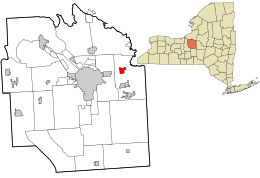Minoa, New York facts for kids
Quick facts for kids
Minoa, New York
|
|
|---|---|
|
Village
|
|

Location in Onondaga County and the state of New York.
|
|
| Country | United States |
| State | New York |
| County | Onondaga |
| Area | |
| • Total | 1.32 sq mi (3.42 km2) |
| • Land | 1.32 sq mi (3.42 km2) |
| • Water | 0.00 sq mi (0.00 km2) |
| Elevation | 413 ft (126 m) |
| Population
(2020)
|
|
| • Total | 3,657 |
| • Density | 2,768.36/sq mi (1,068.92/km2) |
| Time zone | UTC-5 (Eastern (EST)) |
| • Summer (DST) | UTC-4 (EDT) |
| ZIP code |
13116
|
| Area code(s) | 315 |
| FIPS code | 36-47757 |
| GNIS feature ID | 0957426 |
Minoa is a small village located in Onondaga County, New York, United States. It is part of the larger town of Manlius. Minoa is situated to the east of the city of Syracuse. In 2020, about 3,657 people lived there.
Contents
History of Minoa
Minoa is located in an area that was once part of the Central New York Military Tract. This was land set aside for soldiers after the American Revolutionary War.
The village was first known as "Manlius Station." This name came from its role as a stop on the Syracuse and Utica Railroad. This important railroad line was finished in 1839. In 1895, the name was officially changed to Minoa.
Minoa became an official village in 1913. It was once a very important place for railroads. The village is on the eastern edge of what used to be the biggest railroad yard in the world. This huge yard belonged to the New York Central Railroad.
Famous People from Minoa
- Larry Costello: He was a professional basketball player and coach. He is a member of the Basketball Hall of Fame.
Where is Minoa?
Minoa is located at coordinates 43°4′37″N 76°0′25″W / 43.07694°N 76.00694°W. This helps us find its exact spot on a map.
The United States Census Bureau says the village covers about 1.2 square miles (3.42 square kilometers). All of this area is land, with no large bodies of water inside the village limits.
Population Facts
| Historical population | |||
|---|---|---|---|
| Census | Pop. | %± | |
| 1920 | 867 | — | |
| 1930 | 899 | 3.7% | |
| 1940 | 902 | 0.3% | |
| 1950 | 1,008 | 11.8% | |
| 1960 | 1,838 | 82.3% | |
| 1970 | 2,245 | 22.1% | |
| 1980 | 3,640 | 62.1% | |
| 1990 | 3,745 | 2.9% | |
| 2000 | 3,348 | −10.6% | |
| 2010 | 3,449 | 3.0% | |
| 2020 | 3,657 | 6.0% | |
| U.S. Decennial Census | |||
In the year 2000, there were 3,348 people living in Minoa. These people lived in 1,249 households. A household is a group of people living together in one home. About 940 of these households were families.
The population was spread out by age. About 26.1% of the people were under 18 years old. About 13.8% were 65 years old or older. The average age of people in Minoa was 39 years.
The average household had about 2.62 people. For families, the average size was about 3.03 people.
Schools in Minoa
The public schools in Minoa are part of the East Syracuse-Minoa Central School District.
See Also
 In Spanish: Minoa para niños
In Spanish: Minoa para niños

